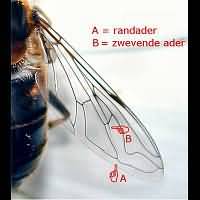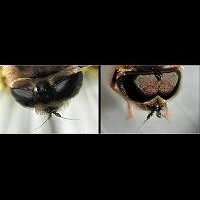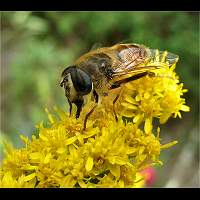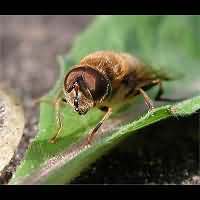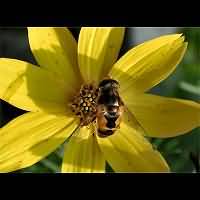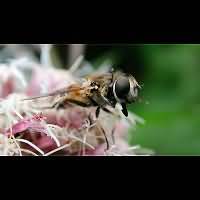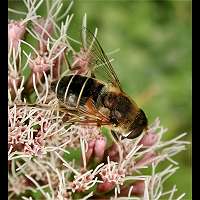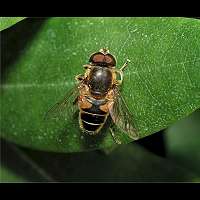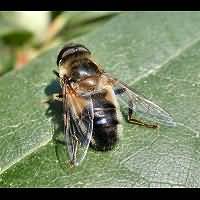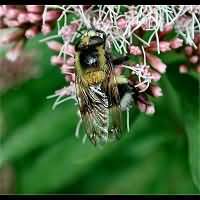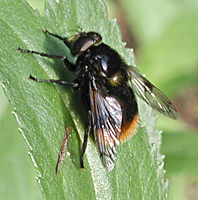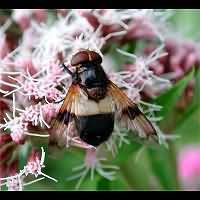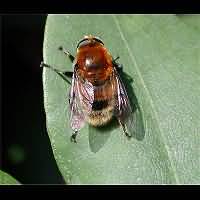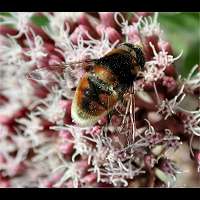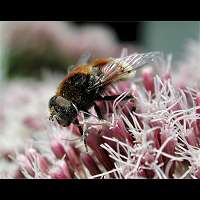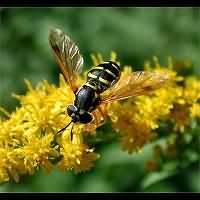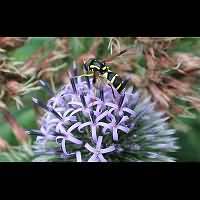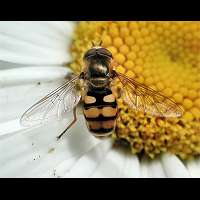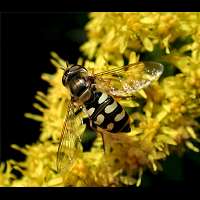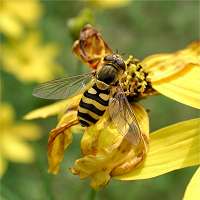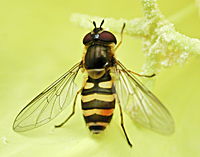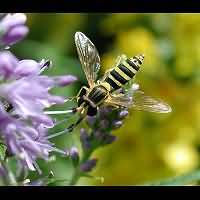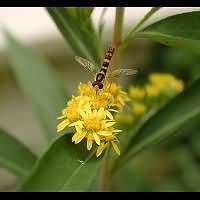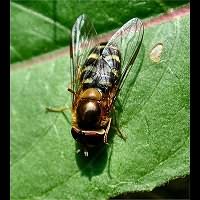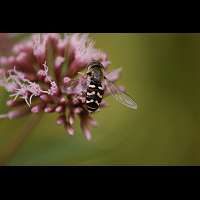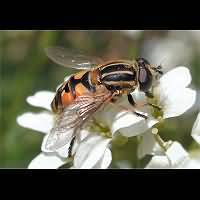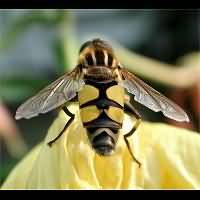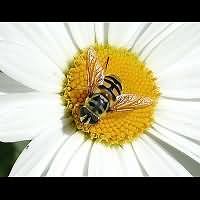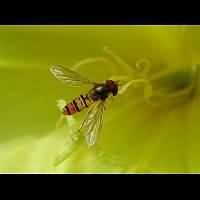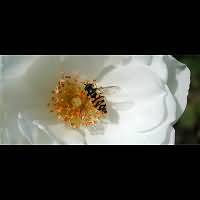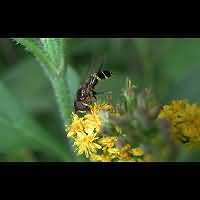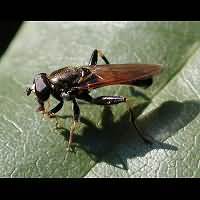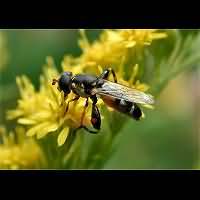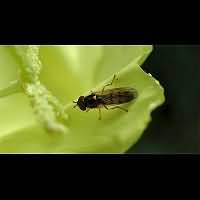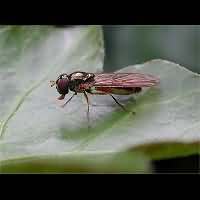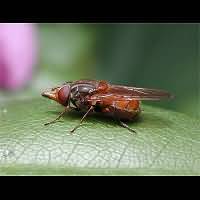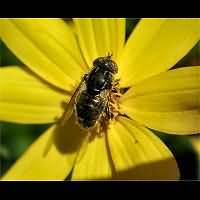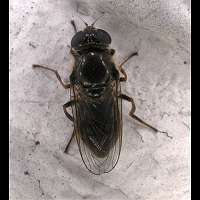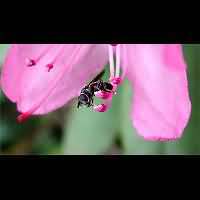[All pictures of garden wildlife on this page are thumbnails. Click on any thumbnail for a large format to be displayed.]
Contents: 1 introduction to hover flies, 2 Bee like hover flies, 3 Bumble Bee like hover flies, 4 Wasp like hover flies, 5 Other hover flies.
![]()
Hoverflies or Syrphid Flies (or Flower Flies, if you prefer American nomenclature) belong to a big family varying from small to large flies. They are among the most frequent visitors of flowers in the garden. In Holland and Belgium alone there exist over 300 species! In summer the majority is seen in sometimes great numbers mixing with butterflies, bees, bumblebees and other flower adorers. Their strikingly swift flight, the seemingly freezing still in the air and, with some species, their size are remarkable. Some hoverflies are among the biggest flies of Central Europe. Many species are very colourful as well. Yet it is not always that easy to identify them as being hoverflies. Some thick-headed flies and bee flies are quite similar. Besides some hoverflies are very dark creatures and these colours makes it difficult to identify them correctly. If you want be sure whether the animal you are looking at is a hoverfly or not then pay attention to the veins in the wing and compare those with the picture below. In hover flies a great part of the edge of the wing is without veins. The vein running all te way to the edge in most flies, only reaches the last transverse vein, not the edge as in hoverflies (A). Another feature of hoverflies is the so-called 'floating vein' (B). This vein just ends nowhere. Usually veins end either at the edge of the wing or in another vein. Both these features being present means you are actually looking at a hoverfly.
Veins in the wings of hoverflies: A veinless part of the edge, B "floating vein".
Just like all other flies hoverflies go through all stages of insect life: egg-larva-pupa-imago. The larvae of hoverflies are remarkably diverse for just one family of flies. Some live in extremely dirty water (including stale), eating all kinds of decaying materials. To be able to breath in such an environment they developed a long pipe at the rear end of the body which they stick up into the air. Other larvae hunt for plant lice. Some live in decaying wood, while some are a pest in agriculture for eating roots and flower bulbs from within. Like with so many other flies males and females often look alike wearing the same colouring, patters and being of similar size. Exceptions are found especially among the drone flies where females differ from the males. Nevertheless it is always easy to tell males and females apart. Like all other flies the males have much bigger eyes. These eyes almost touch eachother in the middle. Females have much smaller eyes, placed further apart. Just look at the picture below.
Telling from the eyes which is which: a female to the left, a male to the right.
Scientifically the hoverfly family, Syrphidae, has been divided into several subfamilies. However on Gardensafari pages I prefer to use another division, the one according to shape and colouring. That is why I group the hoverflies into bee-like, bumblebee-like, wasp-like and others. Bee-like hoverflies have dark brown bodies, often ith small white bands and orangelike spots. They include the famous droneflies. Bumblebee-like hoverflies are often large, hairy creatures with broad white or yellow bands around the body, such as Volucella species. Wasp-like hoverflies are black with yellow or white spots. Most hoverflies belong to this group. The other hoverflies include a few very dark species and the famous Heineken Fly. I do stress however that this is my own division and it is without any scientific justification!
The Drone Flies (Eristalis tenax) below can be seen in everybody's garden in summer. Larvae of the Drone Fly are very remarkable. They live in stale and very polluted water with almost no oxygen. As a solution to this problem they developed a very long tube on the backside of the body. This tube sticks out of the water like a kind of a periscope and is used to breath through. This tube is probably the reason why in Dutch they are called Rat's Tail Larvae. The Drone Fly resembles a common Honey Bee very much. It is more robust, shiny and a little darker though. The two animals can also easily be told apart by their eyes: Drone Flies have very large eyes, typical for flies. Drone Flies make up the infamous genus of Eristalis. Infamous because this genus is comprised of some 15 species and these species are real look-a-likes and extremely difficult to tell apart. The females are even harder to identify for not only are they extremely variable, they often also lack the orange spots commonly found on males. Below two very common species: Eristalis tenax and Eristalis pertinax. The difference between the two species is the last part of the leg, just above the foot: in E. tenax it is always black and in E. pertinax it is always yellow. Also Eristalis tenax has two dark lines in the eyes. These actually are streaks of hair. In the field you need the right light to be able to see the difference, though.
To the left the one and only real Drone Fly (Eristalis tenax), to the right its close relative Eristalis pertinax.
Another frequent visitor to our garden is the slightly smaller species Eristalis arbustorum. The males can be identified by their orange spot which shows a small triangle. The female may have a much smaller spot, or can even be spotless alltogether. The best way to identify her is by looking at the face: it shows bright white hairs all over.
Eristalis arbustorum: a male to the left, a female's head to the right.
Another frequent visitor to gardens is Eristalis interruptus below. It rather looks like all the other Drone Fly species, but can be identified by the black spot in the wing near the edge: it is a small black dot and not a bigger blob. The other details helping you telling this species apart are more difficult to distinguish and goes far beyond the scope of this website. Due to the fact that many species are highly variable you need some experience in identifying the individual species. Scientifically this species is also known as Eristalis nemorum.
To the left a female and to the right the male of yet another very common Drone Fly species: Eristalis interruptus.
Many other Eristalis species are also difficult to identify. Below is a species of which the identity is tentative. In order to be able to determine it, you would have to catch it. There are identification tables in which you can look up the species you've caught. The differences between the various species can often only be told by looking at a combination of very small details, or by examining the genitals.
Yet another Eristalis species? According to some this could be Eristalis pratorum, but the identification is very tentative!
Various hover flies imitate bumblebees, but you have to be careful: most bee flies also look like bumblebees. The bee flies are even bigger than the hoverflies, extremely hairy and they have a very long snout. Because of this snout they often hover in front of flowers, collecting the nectar the same way as hummingbirds do. Hoverflies always land down on a flower before taking the nectar out of it. Some hoverflies imitate bumblebees so well, you might have a problem telling them apart. Hoverflies however are better flyers than bumblebees and they have much shorter antennae end and bigger fly-like eyes. Volucella bombylans below imitates bumblebees. The species is extremely variable, as it imitates various bumblebees. The one below to the left obviously wants to look like the Earth Bumblebee (Bombus terrestris), while the one to the left imitates the Red-tailed Bumblebee. It is hard to imagine they belong to one and the same species! In such cases it is a good habit to use the longer scientific names. Starting of with the name of the genus, starting with a capital (in this cae Volucella), followed by the name of the species (in this case bombylans) followed by the name of the form or subspecies. The imitator of the Red-tailed Bumblebee is scientifically known as Bombylans bombylans bombylans. The subspecies mimicing the Earth (or Garden) Bumblebee is called Volucella bombylans plumata. The larvae of this hoverfly lives in the nests of bumblebees, eating the rubbish the bees produce and possibly the bees larvae as well. You'll find a good comparison between the Bumblebee and its imitator on another page, which you can open by clicking on the animal's name in the caption.
Twice Volucella bombylans. To the left V. b. plumata and to the right V. b. bombylans.
Apart from Horse Flies most flies can't bite. They simply vomit the juices from their stomch onto their food and suck the liquids up again. This habit is exactly what makes Bluebottles and House Flies dangerous: their vomit contains lots of bacteria dangerous to man. Hoverflies are not dangerous at all, as they will never voluntarily enter our houses. Below to the left you see a very beautiful hoverfly, called the Pellucid Hoverfly. The species can be identified easily by the beautiful ivory white band and the dark spots in the wings. In this way it imitates bumblebees although it does a rather poor job for it is even hairless. The larvae can be found in Bumblebee nests. Probably they eat both: waist products and bumblebee larvae. Below to the right another hoverfly imitating bumblebees: the Greater Bulb-fly, also known as the Narcissus-bulb Fly. It too is quite variable, but less then the species above. The distinctions between the two hoverfly species are the black spot in the wings of Volucella bombylans, which the Greater Bulb-fly lacks and also by the veins in the wings, which show some twists and turns in the Greater Bulb-fly, while being rather straight in Volucella bombylans. The larvae of the Greater Bulb-fly also behave differently: they live in bulbs of various plants, sometimes even becoming a pest in the garden.
The Pellucid Hoverfly (Volucella pelluscens) to the left is one of the biggest flies in Central Europe. The Great Bulbfly (Merodon equestris) to the right sometimes becomes a pest in Daffodils.
This is a member of the Eristalis group comprised of hoverflies imitating bees. And you can still see the characteristic markings on the back of this species. By growing long thick hairs it mimics a bumblebee as well. Some animals are hairier than others and the colouring may be different from the one in this picture as well. The backside may be reddish or black instead of white. We do not know whether this is a British species as well. In continental Europe this is an abundant species although is cannot be spotted easily as it rarely visits flowers. The larvae live on rotting plant material.
A bee imitator mimicking a bumblebee: Eristalis intricaria does it an intricate way.
Most hoverflies imitate wasps. They are black with yellow or white stripes or patches. There is a lot of variety among them both in size and colours. This is understandable bause this is the way wasps are as well. By far the best wasp imposters are shown below. To the left a fly from the genus Chrysotoxum. Not only do they have wasp-like strips, they also developed dark wings, resembling those of the social wasps. Their antennae are remarkable as well: extremely long and wasp like, not found in many other flies. Sometimes you have to look twice to see that it is a fly and not a wasp! The genus is notorious for the many look-a-like species. The larvae live in decaying wood. The one to the right is apparently common in some parts of the British Isles as well, but has no common English name. There are a few closely related species looking very much like this one. Gardensafari thanks Han Endt (NL) for identifying this species.
Two perfect wasp mimics: to the left Chrysotoxum festivum and to the right Xanthogramma pedissequum.
The species below often appears in great numbers and is present all over Europe, including all of the British Isles. Has been introduced in South Africa and does wonderfully well there too. It is neither a big nor a small species reaching a length of some 9 mm. It is often bred as the larvae are superb aphid eaters. It is especially used on plantations growing of Chrysanthemum and spinach. When the weather is fine this hoverfly may produce some 6 to 7 generations in one season (it is on the wing from June to September or October). The lifecycle is short and eggs may hatch just two days after being laid. Next, the larva will feed on aphids for some 10 days, during which period it may consume up to 800 aphids. After that the larva pupates. The duration of the pupal stage is again very short: after only 8 days a newborn adult comes out. And should it be a female, then she is capable of producing approximately 1,000 eggs in her lifetime! So this is an ideal species for use as a biological weapon against pests in agriculture. This species is still often referred to by its previous scientific name: Metasyrphus corollae.
This common species often is abundantly present in one's garden: Eupeodes corollae.To the left a male, to the right a female.
The genus Syrphus is comprised of, among others, three look-a-like species. Telling apart Syrphus torvus, S. ribesii en S. vitripennis can be troublesome at times. Yet it is somtimes possible. Syrphus torvus, below to your left, for instance is the only one having hairy eyes. This is quite visible in males, females are less obvious, so you probably have to catch them and look into their eyes from various angles. Syrphus torvus likes woodlands and the edges of woods, but may appear in great numbers. It is a well known migrating species, on the wing from March to September. It is an extremely common species in Europe, Asia and Northern America. The other two Syrphus species are hard to tell apart, especially the males. For females there is a clue though: if the thighs are blackish it is Syrphus vitripennis, the smallest of the three. If the thighs are yellow it is Syrphus ribesii, the biggest of the three. The picture below to the right is not completely convincing, for we would like to see more of the thigh, but it is very likely the thigh is completely yellow. The animal clearly is a female and so this should be Syrphus ribesii. This too is a very common species, but less inclined to migrate. It flies from April to September. The larvae of all species feed on aphids and are considered to be useful. The larvae of Syrphus ribesii are a welcome guest by farmers all around the world as they feed on aphids found on berries. The literal transaltion of the Latin name of this species tells us that this is a 'currant' hoverfly.
Syrphus torvus to the left has hairy eyes, but often you have to catch it in order to be able to see that. The thighes of the female of Syrphus ribesii to the right are completely yellow.
The hoverflies of the gender Sphaerophoria are all small, black with yellow lining and very similar to one another. The male animal depicted to the right is recognisable as its body is longer than its wings are. That is why it is Sphaerophoria scripta. So we would not be surprised if the female to the left turns out to be the same species. We will however never be certain because apparently there is no way to tell the females apart.
To the left a female Sphaerophoria sp. and to the right a male Sphaerophoria scripta.
The Hoverflies below also use mimicry to defend themselves. Actually for the one to the left the trick should fail as the spots on its body are not yellow as one might expect, but are more or less white. In summer there are lots of these flies, especially on flowers, so apparently the mimicking trick somehow works with white as well as it does with yellow! The two Scaeva species below are not very easy to identify. However S. selenitica tends to have the spots on the abdomen in a yellowish colour, while those of S. pyrastri tend to be white. Furthermoe there are slight differences in the shapes of these spots. In our garden S. selenitica seems to be predominant.
To the left Scaeva selenitica, the most common Scaeva species in our garden. To the right look a like Scaeva pyrastri, usually a very common species, also to be found in many gardens.
With many species you can hear the buzzing of the wings, keeping the animal in place in flight. Especially on lazy, warm summerdays this sound is striking. Two very common, larger hoverflies are depicted below. To the left the Striped Hoverfly and to the right its look alike cousin. Apparently the latter has to go through life without a common English name. In some gardens the first may be predominant, in other gardens the latter. Even though they are look alikes, you can tell them apart by close visual examination. The Striped Hoverfly is slightly smaller and the markings on the second abdominal segment are darker, even with shades of orange. The stripes on the third segment are used to tell them apart. In the Striped Hoverfly the lines never meet in the middle. There is a clear black spot separating them. In H. trivittatus however the lines (almost) meet in the middle.
To the left the Striped Hoverfly (Helophilus pendulus), to the right the almost identical Helophilus trivittatus.
The species to the left is also common in many gardens. It rather looks like many other species, but is unique in one way: the lines on the thorax run across. From certain perspectives it even looks like the animal has a skull-like pattern. Therefore in Dutch it is called the skull hoverfly. The Marmelade Hoverfly (also known as Twin-barred Hoverfly) below is not difficult to identify. It is much smaller than the species above, but even more colourful. It is a remarkable species though because adult females often overwinter. In most hoverflies it is the egg, larva or pupa overwintering. This species seems to be migrating as lots of adults travel to Southern Europe in autumn, some go even across the Alps.
To the left the unique Myathropa florea and to the right the rather small Marmelade Fly (Episyrphus balteatus).
Below two rather small but colourful species. Apparently they have to try to survive with no common name in English. Try to get the one to the right in your garden, preferably in great numbers, for the larvae feed on plant lice.
Two small species: Didea fasciata, a woodland species to the right. Dasysyrphus tricinctus is the name of the one to the right.
For a long time we thought that the fly below to the left was a Soldier Fly. But luckily Hans-Peter Tschorsnig corrected us. It is a hoverfly that doesn not look much like the other hoverflies. Usually it sits in the sunshine on a leaf and it obviously rarely visits flowers. Another fequent visitor in our garden is the very small hoverfly to the right. It is easy to identify the little devil, for it has a curiously thickened hindleg with a red spot on it! From a distance it looks very plain indeed, but its real beauty unfolds when you look from extreme close-by.
To the left: This unusual Hover Fly is called Xylota segnis. To the right: Syritta pipiens is a beautiful hover fly, at least when you take a closer look.
The species below to your left looks like S. pipiens above very much but it lacks the thickenings in the thighs. It is a hoverfly that is very common and often more abundant in your garden than you would believe, but the species is very unobtrusive indeed. It is quite common throughout the entire country. Here it is photographed in an Evening Primrose. The flowers of this plant provide excellent backgrounds for photographers! To the right its cousin Melanostoma scalare. It is even darker, more slender and reaching a length of 9 mm, about 1 mm bigger. In the field however that is not easy to see. Luckily many males have a strikingly greenish halters. Males and females differ very much, though. Both species are welcome visitors to the garden, for their larvae feed on aphids. And by the way: thanks to Hans Endt (NL) for the identification of these species.
To the left the very common Melanostoma mellinum. To the right the slightly less common Melanostoma scalare.
A strange hoverfly is the Heineken Hover Fly below to the left. It is coloured like a bee, but does not really look like one, mainly because of the snout. It is very common all over Europe. The larvae live in dung, especially in cow dung. This species is easily identified, for there is no other species like it. For a long time we did not know the identity of the species below to the right. The way the veins are arranged in the wings suggested a hoverfly, but the wings are very small and we did not know of any hoverfly having such beautiful eyes. Luckily Han Endt (NL) identified the animal. In Dutch it is called the Meadow Spotted Eyes, but alas, we did not find a common English name. Remarkable about this hoverfly is the lack of the mentioned 'floating vein'. Be aware identifying this species though. There is a very similar species, also with strikingly marked eyes: Eristalinus aeneus. This species however can only be found right at the coast, or on the banks of some large lakes. The species has a vast territory: it can be found not only in Europe and Asia, but in Japan and Northern America as well!
The famous Heineken Fly (Rhingia campestris) to the left is a hover fly as well. To the right the very striking Eristalinus sepulchralis, related to the Drone Flies.
Species belonging to the genus Cheilosia are mainly black. There are some 40 species here in the Benelux, all very similar. Many species will reach a length of well over 10 mm. So far we have identified only one: Cheilosia caerulescens, of which you can see the picture below. For identification purposes check the following features: the eyes are hairless, the legs are partially yellow, the scutellum is black and the middle vein in the wing is darkened. Chances are however you'll never see it, for as far as we know it is not a British species. Very small black hoverflies might belong to the Pipiza genus. These are extremely hard to name, for their are at least 5 species, all having the same appearance and all quite variable. To tell the species apart, their genitals have to be studied under a microscope. All species are black, sometimes with yellow markings on the first abdominal segment. These markings are hard to see, for the wings are folded over them. Many species live in woodlands. The larvae eat aphids and other plant juice sucking small insects.
To the left: Cheilosia caerulescens appears regularly in gardens on the continent. To the right: this small, black hoverfly belongs to the Pipiza genus.



© Copyright 1998-2024 gardensafari.net (Hania Berdys)

 English / engels
English / engels  Dutch / nederlands
Dutch / nederlands